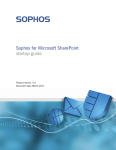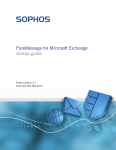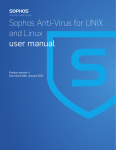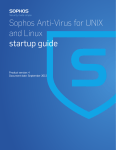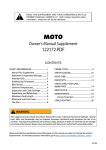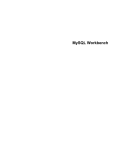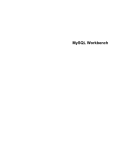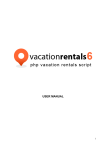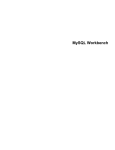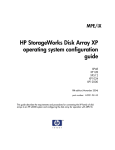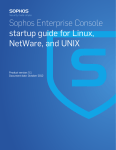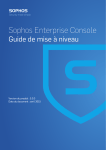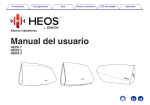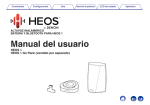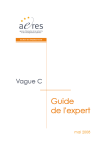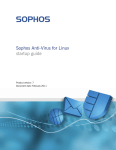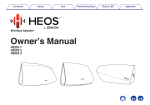Download Sophos for Microsoft SharePoint startup guide
Transcript
Sophos for Microsoft SharePoint startup guide Product version: 2.0 Document date: September 2015 Contents 1 About this guide........................................................................................................................3 2 About Sophos for Microsoft SharePoint....................................................................................3 3 System requirements................................................................................................................3 4 Planning your installation..........................................................................................................3 4.1 Deploying on a stand-alone computer........................................................................4 4.2 Deploying to a server farm environment.....................................................................4 5 Installing Sophos for Microsoft SharePoint...............................................................................4 5.1 Preparing for installation.............................................................................................4 5.2 Install Sophos for Microsoft SharePoint......................................................................5 5.3 Configure firewall........................................................................................................6 5.4 Open the Sophos for Microsoft SharePoint administration web site...........................7 5.5 Allow a user to manage Sophos for Microsoft SharePoint..........................................7 6 Scan types................................................................................................................................7 7 Ensure on-access scan is enabled...........................................................................................8 8 Scan a specific location............................................................................................................9 9 Schedule a scan.....................................................................................................................10 10 Configure anti-virus..............................................................................................................11 11 Configure content filtering....................................................................................................12 12 Modify an existing policy.......................................................................................................12 13 Set up alerts.........................................................................................................................14 14 Quarantine items..................................................................................................................15 15 Back up and restore configuration........................................................................................15 16 Uninstalling Sophos for Microsoft SharePoint......................................................................16 16.1 Uninstall sequence.................................................................................................16 16.2 Uninstall Sophos for Microsoft SharePoint.............................................................16 17 Appendix: Database Mirroring..............................................................................................16 17.1 Prepare SQL Server instances...............................................................................17 17.2 Install Sophos for Microsoft SharePoint with database mirroring...........................17 17.3 Configure Sophos for Microsoft SharePoint for database mirroring.......................18 18 Technical support..................................................................................................................22 19 Legal notices........................................................................................................................22 2 startup guide 1 About this guide This guide tells you how you can protect Microsoft Windows SharePoint Services (WSS) 3.0 and Microsoft Office SharePoint Server 2007 and 2010 by installing and setting up Sophos for Microsoft SharePoint version 2.0. If you are installing Sophos for Microsoft SharePoint for the first time, read this guide. If you are upgrading, see the Sophos for Microsoft SharePoint upgrade guide, instead of this guide. You can find details of all configuration options of Sophos for Microsoft SharePoint in the Sophos for Microsoft SharePoint Help. For information on configuring Sophos Anti-Virus, refer to the Sophos Anti-Virus documentation. 2 About Sophos for Microsoft SharePoint Sophos for Microsoft SharePoint is a security solution for Microsoft SharePoint. The key features of Sophos for Microsoft SharePoint include: ■ On-access scanning of the SharePoint store for malware, Potentially Unwanted Applications (PUAs), suspicious files with Host Intrusion Protection System (HIPS), and exceptions to your corporate content by applying content filtering policies. ■ On-demand and scheduled scanning for selected portions of the SharePoint store. The scan includes detection for malware, PUAs, suspicious files (HIPS), and exceptions to your corporate content by applying content filtering policies. ■ A web-based user interface that allows administrators to configure settings, monitor status, perform routine quarantine management tasks, and generate reports. 3 System requirements For system requirements, see the System Requirements for Sophos for Microsoft SharePoint page on the Sophos website. 4 Planning your installation You can deploy Sophos for Microsoft SharePoint to a stand-alone computer or in a server farm environment. 3 Sophos for Microsoft SharePoint 4.1 Deploying on a stand-alone computer In a stand-alone computer scenario, one server runs all the SharePoint server components and the SQL Server data store used by the SharePoint. In this scenario install Sophos for Microsoft SharePoint on the same computer. 4.2 Deploying to a server farm environment In a server farm environment, there may be one or more servers in the farm running the SharePoint server components and SQL Server. In this scenario, install Sophos for Microsoft SharePoint on all the servers that have the SharePoint server components installed. In a farm, in order to manage several Sophos for Microsoft SharePoint servers together, you must select the same SQL Server instance and Sophos for Microsoft SharePoint configuration group during the installation. The servers belonging to the same Sophos for Microsoft SharePoint configuration group will share the same configuration and can be monitored from any of the servers in the configuration group. When installing on the first server choose a remote SQL Server and create a new configuration group. For subsequent installations, choose the same SQL Server and join the existing (newly created) configuration group. In a farm, the data in the SharePoint store is stored by SQL Server and is accessible by each server in the farm. For on-demand and scheduled scans you can select any one of the servers in a configuration group that performs the scan. The configured server can scan all or configured parts of the SharePoint store. 5 Installing Sophos for Microsoft SharePoint 5.1 Preparing for installation When you run the Sophos for Microsoft SharePoint installer, you may be prompted to restart the SharePoint server several times before the installation of the Sophos for Microsoft SharePoint software begins. This depends on the components that are installed as prerequisites. On Windows Server 2012 or Windows Server 2012 R2, Windows PowerShell must be enabled during the installation of Sophos for Microsoft SharePoint. 4 startup guide 5.2 Install Sophos for Microsoft SharePoint To install Sophos for Microsoft SharePoint: 1. Log on to the SharePoint server with local administrator rights. If you are in a domain, you must also be a domain user. For a complete list of permissions that are required for installation, see http://www.sophos.com/en-us/support/knowledgebase/58866.aspx. 2. Find the Sophos for Microsoft SharePoint installer that you downloaded earlier and double-click on it. 3. In the Welcome page, click Next. 4. In the License Agreement page, read the agreement. If you agree with the terms, click I accept the terms of the license agreement and click Next. 5. In the Choose Destination Location page, you see the default folder where Sophos for Microsoft SharePoint will be installed. If you want to install it in a different folder, click Browse and select a folder. Click Next. 6. In the Sophos Download Credentials dialog box, enter the User name and Password that were supplied by Sophos. If you access the internet via a proxy, click Proxy Details and enter your proxy settings. Otherwise, click Next. 7. In the Database Settings page, select one of the following options: ■ Local Select this option if you want to use an SQL Server instance that is present on this server. If no database instance is found, the installer installs a local SQL Server Express 2008 instance on this server. ■ Remote Select this option if you have an SQL Server instance installed on another computer. In the remote SQL database, multiple installations of Sophos for Microsoft SharePoint can use the same database instance, but the database content will not be shared. 8. In the Configuration Group page, select a group you want to join or create a new group. Sophos for SharePoint installations can be grouped together to share the same policy configuration and be managed from a single management console. For more information, see Deploying to a server farm environment (page 4). 5 Sophos for Microsoft SharePoint 9. In the Service Credentials page, enter the credentials for the account that will be used for Sophos for Microsoft SharePoint services. The account must have local administrator rights and full access to the SharePoint store content. Sophos for Microsoft SharePoint uses these credentials to scan and clean items in the SharePoint store. Read http://www.sophos.com/en-us/support/knowledgebase/58866.aspx for more information on which accounts you can use. Note: If you have Windows User Account Control (UAC) enabled, you will be prompted for local administrative privileges with full access rights to the entire SharePoint store. Ensure the account has the necessary privileges and then click Yes to continue. If your computers are in a workgroup, continue to step 13. 10. In the Administrators group page, accept the default group name or provide a different group name. If the installer cannot create the group or if the group does not exist, a message is displayed The group does not exist. Please ask a Domain Administrator to create the group. In this case, contact the domain administrator to create the group and add the installing user and the service user as members to the group. 11. In the Email Alerts page, enter an administrator email address, SMTP server name and port number. The SMTP server must be able to accept anonymous (non-authenticated) emails sent from the Sophos for Microsoft SharePoint server. It must also be able to accept and relay emails sent to [email protected] and the administrator email address. 12. In the Company Information page, you can enter details relating to the size, location, and market sector of your company or organization. This valuable feedback helps SophosLabs analyze email security trends. Click Next. 13. In the Start Copying Files page, ensure the settings are correct. If they are then click Next. If they are not then click the back button to return to previous dialog boxes and correct the settings. 14. Sophos for Microsoft SharePoint displays the installation progress and installs Sophos Anti-Virus and Sophos AutoUpdate (if not already installed). Sophos AutoUpdate automatically downloads updates to virus data and anti-spam rules. Note: In certain circumstances the installation may require you to restart the server. The installation will continue after restarting. 15. When installation is complete, the InstallShield Wizard Complete page is displayed. Click Finish. 5.3 Configure firewall If Sophos for Microsoft SharePoint is installed on a server that has a firewall installed, ensure that the firewall is configured to allow incoming TCP connections to the Sophos for Microsoft SharePoint website port. 6 startup guide The link to Sophos for Microsoft SharePoint in the start menu contains the URL and port number for the administrative web site. For information, see Open the Sophos for Microsoft SharePoint administration web site (page 7). Note: If you are using Windows Server 2008 or later with the default Windows Firewall, the firewall is automatically configured during installation. 5.4 Open the Sophos for Microsoft SharePoint administration web site To open the Sophos for Microsoft SharePoint administration web site from the server on which Sophos for Microsoft SharePoint is installed, click Start > Programs > Sophos > Sophos for Microsoft SharePoint. The shortcut is the URL containing the address and port number of the administration web site. To open the Sophos for Microsoft SharePoint administration web site from another computer, use a web browser to open the appropriate web address. For example, this might be http://192.0.2.0:8081, where 192.0.2.0 is the IP address of the server on which Sophos for Microsoft SharePoint is installed. If you cannot open the Sophos for Microsoft SharePoint administration web site, try the following: ■ Make sure that Javascript is enabled in your web browser. ■ Add the Sophos for Microsoft SharePoint administration web site to the list of trusted sites in your web browser. ■ If you are opening the administration web site from another computer, make sure that access is not blocked by a firewall. ■ If your web browser is configured to use a proxy server, you might need to configure it to (a) either not use a proxy or (b) bypass the proxy server for local addresses. Note: By default, Sophos for Microsoft SharePoint is not configured to use the SSL secured communication. If you want to secure it manually, use the Internet Information Services (IIS) Manager MMC console and configure the 'Sophos for Microsoft SharePoint' website. For more information see the IIS Manager Help. 5.5 Allow a user to manage Sophos for Microsoft SharePoint If you are a domain administrator or a member of the Windows Administrators group, you can allow a user to manage Sophos for Microsoft SharePoint. To do this, you add the user as a member of the Sophos for Microsoft SharePoint Administrators group that was mentioned during installation. 6 Scan types Sophos for Microsoft SharePoint lets you perform three types of scans: 7 Sophos for Microsoft SharePoint On-access scan A scan that intercepts files as they are accessed, and grants access to only those that do not pose a threat to your computer or are authorized for use. On-demand scan A scan of the SharePoint store, or parts of the SharePoint store, that you can run immediately. Scheduled scan A scan of the SharePoint store, or parts of the SharePoint store, that runs at a set time. You can manage each of these scans individually by selecting it from the left pane on the Configuration tab. By default, the configuration tab displays the on-access scan control page. 7 Ensure on-access scan is enabled By default, on-access scanning is enabled for Sophos for Microsoft SharePoint. Note: Microsoft SharePoint or Microsoft Office products may provide incorrect warning messages when the on-access scan blocks files. For information on the messages that are displayed, see http://www.sophos.com/en-us/support/knowledgebase/55263.aspx. To ensure that on-access scanning is enabled: ■ Open Sophos for Microsoft SharePoint. On the navigation bar, the System status tab should display OK with a green icon. In the Dashboard tab, under System Console section, all the servers in the configuration group should have the text Running against on-access scan. 8 startup guide 8 Scan a specific location You can choose to scan only specific areas and files within the SharePoint store when you perform an on-demand or scheduled scan. In a farm, the data in the SharePoint store is stored by SQL Server and is accessible by each server in the farm. For on-demand scan you can select any one of the servers in a configuration group that performs the scan. The configured server can scan all or configured parts of the SharePoint store. To scan a specific location: 1. Open Sophos for Microsoft SharePoint. On the navigation bar, click the Configuration tab. A list of available options is displayed in the left hand pane. 2. Click On-demand scan and then click Scan target settings. The scan target settings page is displayed. 3. In the Scan Location tab, select one of the options: ■ ■ ■ Scan all locations Scan all locations selected below Scan all locations except those selected below 9 Sophos for Microsoft SharePoint 4. Choose the locations that you want to scan from the SharePoint data store structure displayed. ■ To add a location, select it and click "Add" button. ■ To remove a location, select it and click "Remove" button. ■ To remove all locations, click "Remove all" button. Note: The list displaying the SharePoint data store structure displays only folders and not individual files. 5. In the Scan files tab, specify the file names to be scanned within the selected location(s). You must specify each filter on a new line. The file names can contain the wildcard '*' and '?'. The file names specified are not case-sensitive. 6. Click Apply to save the settings. 7. To start the scan, under on-demand scan, click Scan control and click Start. Note: If you modify and save settings while an on-demand scan is active, the changes will take effect the next time the scan is started. 9 Schedule a scan You can schedule a scan to run on a particular day and time. You can also choose to scan the whole or only a part of the SharePoint store during a scheduled scan by editing Scan target settings in the Scheduled scan menu. In a farm, the data in the SharePoint store is stored by SQL Server and is accessible by each server in the farm. For scheduled scan you can select any one of the servers in a configuration group that performs the scan. The configured server can scan all or configured parts of the SharePoint store. You must configure a scheduled scan to ensure all the existing items in the SharePoint store are scanned based on your configuration and new identities that are downloaded from Sophos. To schedule a scan: 1. Open Sophos for Microsoft SharePoint, on the navigation bar click Configuration tab. A list of available options is displayed in the left hand pane. 2. Click Scheduled scan and then click Schedule settings. The schedule settings page is displayed. 3. Select Schedule this scan. 4. Select the Days when the scan will run. 10 startup guide 5. Specify the Scan start time. 6. You can set the Number of minutes after which scan should be aborted, to specify the number of minutes after which the scan is stopped, if it is not yet complete. 7. Click Apply to save the settings. Note: If you modify and save settings while a scheduled scan is active, the changes will take effect the next time the scan is started. 10 Configure anti-virus The anti-virus policies let you define actions to be performed based on the items that are detected. To configure anti-virus policies: 1. Open Sophos for Microsoft SharePoint. On the navigation bar, click the Configuration tab. A list of available options is displayed in the left hand pane. 2. Select a scan and click Anti-virus policy. The Anti-virus policy page displays the following rules: ■ On infection Specifies action for known malware, such as, viruses, Trojans, and spyware. The default action is set to Replace with text. This replaces the file in SharePoint store with a text file using the same file name. The text to be replaced is configurable. ■ On adware/PUA Specifies action for known adware and potentially unwanted applications. The default action for on-access scan is set to Block, for on-demand and scheduled scan no action is specified. By default this rule is disabled. ■ On suspicious file (HIPS) Specifies action for items that are not known to be malware but contents appear to be suspicious and could most likely be malware. By default no action is specified and this rule is disabled. ■ On encrypted Specifies action for files that are encrypted, such as, password protected files. By default no action is specified. 3. You can click on a policy to modify it. For information on how to edit an anti-virus policy, see Modify an existing policy (page 12). For information on supported actions and configuring the anti-virus settings, see the Sophos for Microsoft SharePoint help. 11 Sophos for Microsoft SharePoint 11 Configure content filtering The content filtering policies let you view and create and content filtering rules. Content filtering rules are not enabled by default. Important: We strongly recommend that the content filtering rules are tested on a sample of files before applying to the complete SharePoint store. If you set a rule with replacement action for a common file name, file type, or phrase (for example, Replace with text or Quarantine and replace with text) all or many of the files in the SharePoint store will be replaced and cannot be restored. Alternatively, for a new rule you can initially set the action to Continue and run it. You can view the logs later to check the files that are affected by the rule and then change the action as desired. To change content filtering rules: 1. Open Sophos for Microsoft SharePoint. On the navigation bar, click the Configuration tab. A list of available options is displayed in the left hand pane. 2. Select a scan and click Content filtering policy. The following default rules are available: ■ On restricted file types These files include common virus carrier file types. ■ On offensive language This includes regular expressions for blocking offensive phrases. Note: You can click on a rule name to view or edit details for an existing rule. 3. You can click on a policy to modify it. For information on how to edit a content filtering policy, see Modify an existing policy (page 12). For information on how to create a new rule, block content based on file names, file types, and phrases, or modify an existing content filtering policy, see the Sophos for Microsoft SharePoint user manual. 12 Modify an existing policy You can modify an existing anti-virus policy or content filtering policy. To modify a policy: 1. Open Sophos for Microsoft SharePoint. On the navigation bar, click the Configuration tab. A list of available options is displayed in the left hand pane. 2. Select a scan and click on the Anti-virus policy or Content filtering policy that you want to modify. 12 startup guide 3. The Edit policy rule window is displayed. Click Next. Note: Some of the options described below cannot be modified based on the policy that is chosen. 4. In Rule Type, an option is displayed based on the chosen policy. Click Next. 5. In Rule Action, set a desired action: Note: You can choose a different option for the Upload and Download actions for an on-access scan if you are using a SharePoint 2010 server. Ensure the upload action is the same or more restrictive than the download action. Option Description Continue Indicates no action will be taken on the files but the event is logged and alerts will be sent if configured. Quarantine and continue Quarantines the file but lets you continue to use it. Replace with text Replaces the file in the SharePoint store with a text file using the same file name and extension. The replacement text is configurable. Quarantine and replace with text Quarantines the original file and replaces the file in the SharePoint store with a text file using the same file name and extension. Block Blocks access to files categorized under the event. Note: This option is only available for on-access scan. Quarantine and block Quarantines the file and blocks it from being used. Note: This option is only available for on-access scan. Select Enable to enable the rule and select Alert if you want to be notified via email every time an action is performed. For information on how to set alerts, see Set up alerts (page 14). 6. If you had chosen Replace with text as an option, in Replacement Text, configure the content that should be in the text file that will be replaced in the SharePoint store using the same file name and extension. Click Finish. For information on configuring the replacement text, see Sophos for Microsoft SharePoint Help. Note: SharePoint caches the scan result; hence a file might not be scanned if it is downloaded soon after upload. 13 Sophos for Microsoft SharePoint 13 Set up alerts Sophos for Microsoft SharePoint sends alerts to the administrator email address specified during installation with a default email template. You can customize the content of the email that is received, and modify the email addresses. To configure alerts: 1. In the Sophos for Microsoft SharePoint window. On the navigation bar, click the Configuration tab. A list of available options is displayed in the left hand pane. 2. Click System and then click Alert and Email settings. The Alert and Email settings page is displayed. 3. To modify the content of email, under the Template section: a) Enter the Alert subject, this appears as the subject of the alert. b) Enter the Alert body, this appears as the main body of the alert. c) Enter the Text for each incident, this can be any unique per-incident text you want to display. For a list of substitution symbols and their values, see the Sophos for Microsoft SharePoint Help. 4. To add or modify email addresses, under the Address section: a) Enter the email address to which the alert messages must be sent, one per line. The list can be empty in which case no alert message is sent. b) Enter the Sender email address, this appears as the sender of the alert messages. The sender email address cannot be empty. c) Enter the SMTP mail server address. d) Enter the SMTP port, this cannot be empty and should be a number between 1 and 65536. 5. Click Apply to save the changes. Make sure that the SMTP mail server accepts anonymous (non-authenticated) emails sent from the Sophos for Microsoft SharePoint computer. It should also accept, and be able to relay, emails sent to [email protected] and any recipients specified under the Address section. 14 startup guide 14 Quarantine items Sophos for Microsoft SharePoint can be configured to quarantine an item that: ■ is infected. ■ is adware/PUA. ■ is suspicious (HIPS). ■ is encrypted. ■ contains a blocked file name, file type, or phrase. Quarantined items are isolated in a secured format on disk. You can choose to disinfect, delete, or authorize the items that are classified as PUA or suspicious. For information on how to search for quarantine items and the actions that can be performed on quarantined items, see the Sophos for Microsoft SharePoint user manual. 15 Back up and restore configuration Sophos for Microsoft SharePoint lets you export and import configuration as an XML file. This lets you save and apply the configuration to multiple SharePoint servers. Note: During installation, Sophos for Microsoft SharePoint creates a backup of the default configuration (SophosSharepointDefaultConfig.xml) in the installation directory. The configuration file can be used to restore Sophos for Microsoft SharePoint to factory defaults. To back up and restore configuration: 1. In the Sophos for Microsoft SharePoint window. On the navigation bar, click the Configuration tab. A list of available options is displayed in the left hand pane. 2. Click System, and then click Back up/Restore. The Back up/ Restore option page is displayed. 3. To back up the existing configuration, click Download. A dialog box appears to save the configuration file. 4. To restore the configuration, or apply the configuration on another server, click Browse to open the saved configuration file and then click Upload. A message appears indicating the settings have been successfully restored from the uploaded file. 15 Sophos for Microsoft SharePoint 16 Uninstalling Sophos for Microsoft SharePoint 16.1 Uninstall sequence The Sophos for Microsoft SharePoint uninstallation process will only remove Sophos for Microsoft SharePoint from the computer. If you want to remove Sophos Anti-Virus and Sophos AutoUpdate also, you must uninstall them individually in the following order: 1. Sophos for Microsoft SharePoint 2. Sophos Anti-Virus 3. Sophos AutoUpdate 16.2 Uninstall Sophos for Microsoft SharePoint To uninstall Sophos for Microsoft SharePoint: 1. If the Sophos for Microsoft SharePoint window is open at any location, close it. 2. Open Control Panel and double-click Add/Remove Programs. 3. In the Add/Remove Programs dialog box, select Sophos for Microsoft SharePoint and click Remove. 4. In the Confirm Uninstall message box, click Yes. A progress bar is displayed. Wait for uninstallation to complete. 17 Appendix: Database Mirroring Database mirroring is a feature of SQL Server (available only in the Standard and Enterprise editions of SQL Server since SQL Server 2005 SP1) that provides high-availability without the need for a single-copy cluster. To use mirrored databases with Sophos for Microsoft SharePoint, you must perform the following: 16 ■ Prepare SQL Server instances (page 17) ■ Install Sophos for Microsoft SharePoint with database mirroring (page 17) ■ Configure Sophos for Microsoft SharePoint for database mirroring (page 18) startup guide 17.1 Prepare SQL Server instances Before installing Sophos for Microsoft SharePoint, you must prepare the SQL Server instances that will be used. A mirrored SQL database requires two or three SQL Server instances: 1. A principal server instance (data source). 2. A mirror server instance (failover partner). 3. Optionally, a witness server instance. For information on SQL Server preparation for mirroring, see: https://technet.microsoft.com/en-us/library/ms189852.aspx http://msdn.microsoft.com/en-us/library/ms190941.aspx (Select your version of SQL Server under Other Versions.) Note: ■ Ensure that the SQL Server instances are authenticated to access each other. This means that the accounts under which a SQL Server instances run must be granted access to the other SQL Server instances used in the mirror set, and that remote connections (for example, over the TCP/IP protocol) must be enabled. ■ The principal and mirror server instances should host the same edition of SQL Server, and it should be an edition that supports mirroring. ■ For automatic failover, a witness server is required. ■ For high-availability, the SQL Server instances must be installed on different physical servers and use synchronous mode. ■ If any firewalls exist between the SQL Servers, they must be configured to allow the SQL servers to communicate over the TCP port chosen for mirroring. ■ It is recommended that SQL installations use the same SQL instance name and file paths on all servers. 17.2 Install Sophos for Microsoft SharePoint with database mirroring Database mirroring is enabled in Sophos for Microsoft SharePoint by selecting the Remote database option and supplying the names of both the principal and mirror server instances during installation. The names should be entered in the Sophos for Microsoft SharePoint Database settings dialog box, separated with a semi-colon. Example: Server1\Instance1;Server2\Instance1 Note: Do not include the name of any witness server in the list of instance names. When the instance names are specified separated with a semi-colon, the Sophos for Microsoft SharePoint installer will install the SQL Server Native Client, if it is not already present on the system. If an earlier version of SQL Native Client is available, Sophos for Microsoft SharePoint will upgrade it to SQL Native Client for SQL Server 2008 SP1. 17 Sophos for Microsoft SharePoint If Sophos for Microsoft SharePoint has already been installed without mirroring then these changes can be made retrospectively. For information, contact Sophos Technical Support. 17.3 Configure Sophos for Microsoft SharePoint for database mirroring Once the Sophos for Microsoft SharePoint installation is completed, the databases and Sophos for Microsoft SharePoint login will have been created on the principal server instance. The Sophos for Microsoft SharePoint login is named <domain>\SophosSharePoint, where <domain> is the domain of the Sophos for Microsoft SharePoint Server (or the machine name for a server that is in a workgroup). The following steps can all be performed from the SQL Server Management Studio application, or by issuing the SQL commands provided: For more information on using SQL Server Management Studio see, http://technet.microsoft.com/en-us/library/ms175134.aspx. 1. Create the Sophos for Microsoft SharePoint login on the mirror server instance: [Mirror]> CREATE LOGIN [<domain name>\SophosSharePoint] FROM WINDOWS <domain name> must be replaced with the actual domain of your Sophos for Microsoft SharePoint server, or with the machine name if in a Workgroup. For more information on setting up login accounts, see http://technet.microsoft.com/en-us/library/ms366346.aspx. 2. Perform a full backup for each of the four Sophos for Microsoft SharePoint databases from the principal server: [Principal]> BACKUP DATABASE [SavspCnfg] TO DISK = '<path>\SavspCnfg.bak' [Principal]> BACKUP DATABASE [SavspDir] TO DISK = '<path>\SavspDir.bak' [Principal]> BACKUP DATABASE [SavspQuar] TO DISK = '<path>\SavspQuar.bak' [Principal]> BACKUP DATABASE [SavspRprt] TO DISK = '<path>\SavspRprt.bak' <path> must be replaced with a path to a folder where the backup is to be stored. For more information on preparing a mirror database for mirroring, see http://technet.microsoft.com/en-us/library/ms189047.aspx. 18 startup guide 3. Make the database backup available on the mirror server and restore each database to the mirror server instance. This will set the mirrored databases to Mirror, Synchronized/Restoring state. [Mirror]> RESTORE DATABASE [SavspCnfg] FROM DISK = '<path>\SavspCnfg.bak' WITH NORECOVERY [Mirror]> RESTORE DATABASE [SavspDir] FROM DISK = '<path>\SavspDir.bak' WITH NORECOVERY [Mirror]> RESTORE DATABASE [SavspQuar] FROM DISK = '<path>\SavspQuar.bak' WITH NORECOVERY [Mirror]> RESTORE DATABASE [SavspRprt] FROM DISK = '<path>\SavspRprt.bak' WITH NORECOVERY <path> must be replaced with a path to a folder where the backup is held. If the path names of the principal and mirror databases differ then it will be necessary to use the MOVE option of the RESTORE command. For example: [Mirror]> RESTORE DATABASE [SavspCnfg] FROM DISK = <path>\SavspCnfg.bak' WITH NORECOVERY, MOVE 'SavspCnfg' TO 'C:\Program Files\Microsoft SQL Server\MSSQL.1\MSSQL\DATA\Savspcnfg.mdf', MOVE 'SavspCnfg_log' TO 'C:\Program Files\Microsoft SQL Server\MSSQL.1\MSSQL\DATA\SavspCnfg_1.LDF' For more information on preparing a mirror database for mirroring, see http://technet.microsoft.com/en-us/library/ms189047.aspx. 4. Create a mirroring endpoint on the principal server instance: [Principal]> CREATE ENDPOINT [Mirroring] STATE=STARTED AS TCP (LISTENER_PORT = <port>) FOR DATA_MIRRORING (ROLE = PARTNER) <port> must be replaced with a TCP port number to be used for the endpoint. For example, 7022. 5. Create an endpoint on the mirror server instance: [Mirror]> CREATE ENDPOINT [Mirroring] STATE=STARTED AS TCP (LISTENER_PORT = <port>) FOR DATA_MIRRORING (ROLE = ALL) 19 Sophos for Microsoft SharePoint 6. Point the mirror server instance's partner to the principal server instance: [Mirror]> ALTER DATABASE [SavspCnfg] SET PARTNER = 'TCP://<hostname>:<port>' [Mirror]> ALTER DATABASE [SavspDir] SET PARTNER = 'TCP://<hostname>:<port>' [Mirror]> ALTER DATABASE [SavspQuar] SET PARTNER = 'TCP://<hostname>:<port>' [Mirror]> ALTER DATABASE [SavspRprt] SET PARTNER = 'TCP://<hostname>:<port>' <hostname> must be replaced with the fully-qualified, DNS hostname of the principal server. <port> must be replaced with a TCP port number to be used for the endpoint. For example, 7022. 7. Point the principal server instance's partner to the mirror server instance: [Principal]> ALTER DATABASE [SavspCnfg] SET PARTNER = 'TCP://<hostname>:<port>' [Principal]> ALTER DATABASE [SavspDir] SET PARTNER = 'TCP://<hostname>:<port>' [Principal]> ALTER DATABASE [SavspQuar] SET PARTNER = 'TCP://<hostname>:<port>' [Principal]> ALTER DATABASE [SavspRprt] SET PARTNER = 'TCP://<hostname>:<port>' <hostname> must be replaced with the fully-qualified, DNS hostname of the mirror server. <port> must be replaced with a TCP port number to be used for the endpoint. For example, 7022. For more information on setting up database mirroring using Windows authentication, see http://technet.microsoft.com/en-us/library/ms179306.aspx. 8. If a witness server is required then it can be configured as follows: [Witness]> CREATE ENDPOINT [Mirroring] STATE=STARTED AS TCP (LISTENER_PORT = <port>) FOR DATA_MIRRORING (ROLE = WITNESS) <port> must be replaced with a TCP port number to be used for the endpoint. For example, 7022. 20 startup guide 9. If a witness server is required on the principal server, set the witness for each database: [Principal]> ALTER DATABASE [SavspCnfg] SET WITNESS = 'TCP://<hostname>:<port>' [Principal]> ALTER DATABASE [SavspDir] SET WITNESS = 'TCP://<hostname>:<port>' [Principal]> ALTER DATABASE [SavspQuar] SET WITNESS = 'TCP://<hostname>:<port>' [Principal]> ALTER DATABASE [SavspRprt] SET WITNESS = 'TCP://<hostname>:<port>' <hostname> must be replaced with the fully-qualified, DNS hostname of the witness server. <port> must be replaced with a TCP port number to be used for the endpoint. For example, 7022. For more information on adding a database mirroring witness using Windows authentication, see http://technet.microsoft.com/en-us/library/ms190430.aspx. 10. Depending on the permissions of the accounts running the SQL servers it may be necessary to explicitly grant permissions to the accounts for accessing the endpoints as follows: [Principal]> GRANT CONNECT ON ENDPOINT::[Mirroring] TO [<user>] [Mirror]> GRANT CONNECT ON ENDPOINT::[Mirroring] TO [<user>] [Witness]> GRANT CONNECT ON ENDPOINT::[Mirroring] TO [<user>] <user> must be replaced with the SAM name of account running the accessing SQL Server. 11. If necessary, increase the ping timeout for the connections as follows: [Principal]> ALTER DATABASE [SavspCnfg] SET PARTNER TIMEOUT [Principal]> ALTER DATABASE [SavspDir] SET PARTNER TIMEOUT [Principal]> ALTER DATABASE [SavspQuar] SET PARTNER TIMEOUT [Principal]> ALTER DATABASE [SavspRprt] SET PARTNER TIMEOUT <integer> <integer> <integer> <integer> <integer> must be replaced with the required timeout (in seconds). The default time out used by SQL Server is 10 seconds. 21 Sophos for Microsoft SharePoint 18 Technical support You can find technical support for Sophos products in any of these ways: ■ Visit the SophosTalk community at community.sophos.com/ and search for other users who are experiencing the same problem. ■ Visit the Sophos support knowledgebase at www.sophos.com/en-us/support.aspx. ■ Download the product documentation at www.sophos.com/en-us/support/documentation.aspx. ■ Open a ticket with our support team at https://secure2.sophos.com/support/contact-support/support-query.aspx. 19 Legal notices Copyright © 2009–2015 Sophos Limited. All rights reserved. No part of this publication may be reproduced, stored in a retrieval system, or transmitted, in any form or by any means, electronic, mechanical, photocopying, recording or otherwise unless you are either a valid licensee where the documentation can be reproduced in accordance with the license terms or you otherwise have the prior permission in writing of the copyright owner. Sophos and Sophos Anti-Virus are registered trademarks of Sophos Limited and Sophos Group. All other product and company names mentioned are trademarks or registered trademarks of their respective owners. Boost C++ Libraries Boost Software License - Version 1.0 - August 17th, 2003 Permission is hereby granted, free of charge, to any person or organization obtaining a copy of the software and accompanying documentation covered by this license (the “Software”) to use, reproduce, display, distribute, execute, and transmit the Software, and to prepare derivative works of the Software, and to permit third-parties to whom the Software is furnished to do so, all subject to the following: The copyright notices in the Software and this entire statement, including the above license grant, this restriction and the following disclaimer, must be included in all copies of the Software, in whole or in part, and all derivative works of the Software, unless such copies or derivative works are solely in the form of machine-executable object code generated by a source language processor. THE SOFTWARE IS PROVIDED “AS IS”, WITHOUT WARRANTY OF ANY KIND, EXPRESS OR IMPLIED, INCLUDING BUT NOT LIMITED TO THE WARRANTIES OF MERCHANTABILITY, FITNESS FOR A PARTICULAR PURPOSE, TITLE AND NON-INFRINGEMENT. IN NO EVENT SHALL THE COPYRIGHT HOLDERS OR ANYONE DISTRIBUTING THE SOFTWARE BE LIABLE FOR ANY DAMAGES OR OTHER LIABILITY, WHETHER IN CONTRACT, TORT OR 22 startup guide OTHERWISE, ARISING FROM, OUT OF OR IN CONNECTION WITH THE SOFTWARE OR THE USE OR OTHER DEALINGS IN THE SOFTWARE. Common Public License The Sophos software that is referenced in this document includes or may include some software programs that are licensed (or sublicensed) to the user under the Common Public License (CPL), which, among other rights, permits the user to have access to the source code. The CPL requires for any software licensed under the terms of the CPL, which is distributed in object code form, that the source code for such software also be made available to the users of the object code form. For any such software covered under the CPL, the source code is available via mail order by submitting a request to Sophos; via email to [email protected] or via the web at http://www.sophos.com/en-us/support/contact-support/contact-information.aspx. A copy of the license agreement for any such included software can be found at http://opensource.org/licenses/cpl1.0.php ConvertUTF Copyright 2001–2004 Unicode, Inc. This source code is provided as is by Unicode, Inc. No claims are made as to fitness for any particular purpose. No warranties of any kind are expressed or implied. The recipient agrees to determine applicability of information provided. If this file has been purchased on magnetic or optical media from Unicode, Inc., the sole remedy for any claim will be exchange of defective media within 90 days of receipt. Unicode, Inc. hereby grants the right to freely use the information supplied in this file in the creation of products supporting the Unicode Standard, and to make copies of this file in any form for internal or external distribution as long as this notice remains attached. crt # $FreeBSD$ # @(#)COPYRIGHT 8.2 (Berkeley) 3/21/94 The compilation of software known as FreeBSD is distributed under the following terms: Copyright (c) 1992-2013 The FreeBSD Project. All rights reserved. Redistribution and use in source and binary forms, with or without modification, are permitted provided that the following conditions are met: 1. Redistributions of source code must retain the above copyright notice, this list of conditions and the following disclaimer. 2. Redistributions in binary form must reproduce the above copyright notice, this list of conditions and the following disclaimer in the DOCUMENTATION and/or other materials provided with the distribution. THIS SOFTWARE IS PROVIDED BY THE AUTHOR AND CONTRIBUTORS "AS IS" AND ANY EXPRESS OR IMPLIED WARRANTIES, INCLUDING, BUT NOT LIMITED TO, THE IMPLIED WARRANTIES OF MERCHANTABILITY AND FITNESS FOR A PARTICULAR PURPOSE ARE DISCLAIMED. IN NO EVENT SHALL THE AUTHOR OR CONTRIBUTORS BE LIABLE FOR ANY DIRECT, INDIRECT, INCIDENTAL, SPECIAL, EXEMPLARY, OR CONSEQUENTIAL DAMAGES (INCLUDING, BUT NOT LIMITED TO, PROCUREMENT OF SUBSTITUTE GOODS 23 Sophos for Microsoft SharePoint OR SERVICES; LOSS OF USE, DATA, OR PROFITS; OR BUSINESS INTERRUPTION) HOWEVER CAUSED AND ON ANY THEORY OF LIABILITY, WHETHER IN CONTRACT, STRICT LIABILITY, OR TORT (INCLUDING NEGLIGENCE OR OTHERWISE) ARISING IN ANY WAY OUT OF THE USE OF THIS SOFTWARE, EVEN IF ADVISED OF THE POSSIBILITY OF SUCH DAMAGE. The 4.4BSD and 4.4BSD-Lite software is distributed under the following terms: All of the documentation and software included in the 4.4BSD and 4.4BSD-Lite Releases is copyrighted by The Regents of the University of California. Copyright 1979, 1980, 1983, 1986, 1988, 1989, 1991, 1992, 1993, 1994 The Regents of the University of California. All rights reserved. Redistribution and use in source and binary forms, with or without modification, are permitted provided that the following conditions are met: 1. Redistributions of source code must retain the above copyright notice, this list of conditions and the following disclaimer. 2. Redistributions in binary form must reproduce the above copyright notice, this list of conditions and the following disclaimer in the documentation and/or other materials provided with the distribution. 3. All advertising materials mentioning features or use of this software must display the following acknowledgement: This product includes software developed by the University of California, Berkeley and its contributors. 4. Neither the name of the University nor the names of its contributors may be used to endorse or promote products derived from this software without specific prior written permission. THIS SOFTWARE IS PROVIDED BY THE REGENTS AND CONTRIBUTORS "AS IS" AND ANY EXPRESS OR IMPLIED WARRANTIES, INCLUDING, BUT NOT LIMITED TO, THE IMPLIED WARRANTIES OF MERCHANTABILITY AND FITNESS FOR A PARTICULAR PURPOSE ARE DISCLAIMED. IN NO EVENT SHALL THE REGENTS OR CONTRIBUTORS BE LIABLE FOR ANY DIRECT, INDIRECT, INCIDENTAL, SPECIAL, EXEMPLARY, OR CONSEQUENTIAL DAMAGES (INCLUDING, BUT NOT LIMITED TO, PROCUREMENT OF SUBSTITUTE GOODS OR SERVICES; LOSS OF USE, DATA, OR PROFITS; OR BUSINESS INTERRUPTION) HOWEVER CAUSED AND ON ANY THEORY OF LIABILITY, WHETHER IN CONTRACT, STRICT LIABILITY, OR TORT (INCLUDING NEGLIGENCE OR OTHERWISE) ARISING IN ANY WAY OUT OF THE USE OF THIS SOFTWARE, EVEN IF ADVISED OF THE POSSIBILITY OF SUCH DAMAGE. The Institute of Electrical and Electronics Engineers and the American National Standards Committee X3, on Information Processing Systems have given us permission to reprint portions of their documentation. In the following statement, the phrase "this text" refers to portions of the system documentation. Portions of this text are reprinted and reproduced in electronic form in the second BSD Networking Software Release, from IEEE Std 1003.1-1988, IEEE Standard Portable Operating System Interface for Computer Environments (POSIX), copyright C 1988 by the Institute of Electrical and Electronics Engineers, Inc. In the event of any discrepancy between these versions and the original IEEE Standard, the original IEEE Standard is the referee document. In the following statement, the phrase "This material" refers to portions of the system documentation. This material is reproduced with permission from American National Standards Committee X3, on Information Processing Systems. Computer and Business Equipment Manufacturers Association (CBEMA), 311 First St., NW, Suite 500, Washington, DC 20001-2178. 24 startup guide The developmental work of Programming Language C was completed by the X3J11 Technical Committee. The views and conclusions contained in the software and documentation are those of the authors and should not be interpreted as representing official policies, either expressed or implied, of the Regents of the University of California. NOTE: The copyright of UC Berkeley's Berkeley Software Distribution ("BSD") source has been updated. The copyright addendum may be found at fttp://ftp.cs.berkeley.edu/pub/4bsd/README.Impt.License. Change and is included below. July 22, 1999 To All Licensees, Distributors of Any Version of BSD: As you know, certain of the Berkeley Software Distribution ("BSD") source code files require that further distributions of products containing all or portions of the software, acknowledge within their advertising materials that such products contain software developed by UC Berkeley and its contributors. Specifically, the provision reads: "3. All advertising materials mentioning features or use of this software must display the following acknowledgement: This product includes software developed by the University of California, Berkeley and its contributors." Effective immediately, licensees and distributors are no longer required to include the acknowledgement within advertising materials. Accordingly, the foregoing paragraph of those BSD Unix files containing it is hereby deleted in its entirety. William Hoskins Director, Office of Technology Licensing University of California, Berkeley curl COPYRIGHT AND PERMISSION NOTICE Copyright (c) 1996 - 2014, Daniel Stenberg, <[email protected]>. All rights reserved. Permission to use, copy, modify, and distribute this software for any purpose with or without fee is hereby granted, provided that the above copyright notice and this permission notice appear in all copies. THE SOFTWARE IS PROVIDED "AS IS", WITHOUT WARRANTY OF ANY KIND, EXPRESS OR IMPLIED, INCLUDING BUT NOT LIMITED TO THE WARRANTIES OF MERCHANTABILITY, FITNESS FOR A PARTICULAR PURPOSE AND NONINFRINGEMENT OF THIRD PARTY RIGHTS. IN NO EVENT SHALL THE AUTHORS OR COPYRIGHT HOLDERS BE LIABLE FOR ANY CLAIM, DAMAGES OR OTHER LIABILITY, WHETHER IN AN ACTION OF CONTRACT, TORT OR OTHERWISE, ARISING FROM, OUT OF OR IN CONNECTION WITH THE SOFTWARE OR THE USE OR OTHER DEALINGS IN THE SOFTWARE. Except as contained in this notice, the name of a copyright holder shall not be used in advertising or otherwise to promote the sale, use or other dealings in this Software without prior written authorization of the copyright holder. 25 Sophos for Microsoft SharePoint dtoa.c The author of this software is David M. Gay. Copyright © 1991, 2000 by Lucent Technologies. Permission to use, copy, modify, and distribute this software for any purpose without fee is hereby granted, provided that this entire notice is included in all copies of any software which is or includes a copy or modification of this software and in all copies of the supporting documentation for such software. THIS SOFTWARE IS BEING PROVIDED "AS IS", WITHOUT ANY EXPRESS OR IMPLIED WARRANTY. IN PARTICULAR, NEITHER THE AUTHOR NOR LUCENT MAKES ANY REPRESENTATION OR WARRANTY OF ANY KIND CONCERNING THE MERCHANTABILITY OF THIS SOFTWARE OR ITS FITNESS FOR ANY PARTICULAR PURPOSE. expat Copyright (c) 1998, 1999, 2000 Thai Open Source Software Center Ltd Permission is hereby granted, free of charge, to any person obtaining a copy of this software and associated documentation files (the "Software"), to deal in the Software without restriction, including without limitation the rights to use, copy, modify, merge, publish, distribute, sublicense, and/or sell copies of the Software, and to permit persons to whom the Software is furnished to do so, subject to the following conditions: THE SOFTWARE IS PROVIDED "AS IS", WITHOUT WARRANTY OF ANY KIND, EXPRESS OR IMPLIED, INCLUDING BUT NOT LIMITED TO THE WAR ECRANTIES OF MERCHANTABILITY, FITNESS FOR A PARTICULAR PURPOSE AND NONINFRINGEMENT. IN NO EVENT SHALL THE AUTHORS OR COPYRIGHT HOLDERS BE LIABLE FOR ANY CLAIM, DAMAGES OR OTHER LIABILITY, WHETHER IN AN ACTION OF CONTRACT, TORT OR OTHERWISE, ARISING FROM, OUT OF OR IN CONNECTION WITH THE SOFTWARE OR THE USE OR OTHER DEALINGS IN THE SOFTWARE. IEEE Software Taggant Library This software was developed by The Institute of Electrical and Electronics Engineers, Incorporated (IEEE), through the Industry Connections Security Group (ICSG) of its Standards Association. Portions of it include software developed by the OpenSSL Project for use in the OpenSSL Toolkit (http://www.openssl.org/), and those portions are governed by the OpenSSL Toolkit License. IEEE License Copyright (c) 2012 IEEE. All rights reserved. Redistribution and use in source and binary forms, with or without modification, are permitted provided that the following conditions are met: 1. Redistributions of source code must retain the above copyright notice, this list of conditions and the following disclaimer. 2. Redistributions in binary form must reproduce the above copyright notice, this list of conditions and the following disclaimer in the documentation and/or other materials provided with the distribution. 26 startup guide 3. All advertising materials mentioning features or use of this software must display the following acknowledgment: "This product includes software developed by the IEEE Industry Connections Security Group (ICSG)". 4. The name "IEEE" must not be used to endorse or promote products derived from this software without prior written permission from the IEEE Standards Association ([email protected]). 5. Products derived from this software may not contain "IEEE" in their names without prior written permission from the IEEE Standards Association ([email protected]). 6. Redistributions of any form whatsoever must retain the following acknowledgment: "This product includes software developed by the IEEE Industry Connections Security Group (ICSG)". THIS SOFTWARE IS PROVIDED "AS IS" AND "WITH ALL FAULTS." IEEE AND ITS CONTRIBUTORS EXPRESSLY DISCLAIM ALL WARRANTIES AND REPRESENTATIONS, EXPRESS OR IMPLIED, INCLUDING, WITHOUT LIMITATION: (A) THE IMPLIED WARRANTIES OF MERCHANTABILITY AND FITNESS FOR A PARTICULAR PURPOSE; (B) ANY WARRANTY OF NON-INFRINGEMENT; AND (C) ANY WARRANTY WITH RESPECT TO THE QUALITY, ACCURACY, EFFECTIVENESS, CURRENCY OR COMPLETENESS OF THE SOFTWARE. IN NO EVENT SHALL IEEE OR ITS CONTRIBUTORS BE LIABLE FOR ANY DIRECT, INDIRECT, INCIDENTAL, SPECIAL, EXEMPLARY, OR CONSEQUENTIAL DAMAGES, (INCLUDING, BUT NOT LIMITED TO, PROCUREMENT OF SUBSTITUTE GOODS OR SERVICES; LOSS OF USE, DATA, OR PROFITS; OR BUSINESS INTERRUPTION) HOWEVER CAUSED AND ON ANY THEORY OF LIABILITY, WHETHER IN CONTRACT, STRICT LIABILITY, OR TORT (INCLUDING NEGLIGENCE OR OTHERWISE) ARISING IN ANY WAY OUT OF THE USE OF THIS SOFTWARE, EVEN IF ADVISED OF THE POSSIBILITY OF SUCH DAMAGE AND REGARDLESS OF WHETHER SUCH DAMAGE WAS FORESEEABLE. THIS SOFTWARE USES STRONG CRYPTOGRAPHY, WHICH MAY BE SUBJECT TO LAWS AND REGULATIONS GOVERNING ITS USE, EXPORTATION OR IMPORTATION. YOU ARE SOLELY RESPONSIBLE FOR COMPLYING WITH ALL APPLICABLE LAWS AND REGULATIONS, INCLUDING, BUT NOT LIMITED TO, ANY THAT GOVERN YOUR USE, EXPORTATION OR IMPORTATION OF THIS SOFTWARE. IEEE AND ITS CONTRIBUTORS DISCLAIM ALL LIABILITY ARISING FROM YOUR USE OF THE SOFTWARE IN VIOLATION OF ANY APPLICABLE LAWS OR REGULATIONS. Info-ZIP Copyright © 1990–2007 Info-ZIP. All rights reserved. For the purposes of this copyright and license, “Info-ZIP” is defined as the following set of individuals: Mark Adler, John Bush, Karl Davis, Harald Denker, Jean-Michel Dubois, Jean-loup Gailly, Hunter Goatley, Ed Gordon, Ian Gorman, Chris Herborth, Dirk Haase, Greg Hartwig, Robert Heath, Jonathan Hudson, Paul Kienitz, David Kirschbaum, Johnny Lee, Onno van der Linden, Igor Mandrichenko, Steve P. Miller, Sergio Monesi, Keith Owens, George Petrov, Greg Roelofs, Kai Uwe Rommel, Steve Salisbury, Dave Smith, Steven M. Schweda, Christian Spieler, Cosmin Truta, Antoine Verheijen, Paul von Behren, Rich Wales, Mike White 27 Sophos for Microsoft SharePoint This software is provided “as is,” without warranty of any kind, express or implied. In no event shall Info-ZIP or its contributors be held liable for any direct, indirect, incidental, special or consequential damages arising out of the use of or inability to use this software. Permission is granted to anyone to use this software for any purpose, including commercial applications, and to alter it and redistribute it freely, subject to the following restrictions: 1. Redistributions of source code must retain the above copyright notice, definition, disclaimer, and this list of conditions. 2. Redistributions in binary form (compiled executables and libraries) must reproduce the above copyright notice, definition, disclaimer, and this list of conditions in documentation and/or other materials provided with the distribution. The sole exception to this condition is redistribution of a standard UnZipSFX binary (including SFXWiz) as part of a self-extracting archive; that is permitted without inclusion of this license, as long as the normal SFX banner has not been removed from the binary or disabled. 3. Altered versions—including, but not limited to, ports to new operating systems, existing ports with new graphical interfaces, versions with modified or added functionality, and dynamic, shared, or static library versions not from Info-ZIP—must be plainly marked as such and must not be misrepresented as being the original source or, if binaries, compiled from the original source. Such altered versions also must not be misrepresented as being Info-ZIP releases--including, but not limited to, labeling of the altered versions with the names "Info-ZIP" (or any variation thereof, including, but not limited to, different capitalizations), "Pocket UnZip," "WiZ" or "MacZip" without the explicit permission of Info-ZIP. Such altered versions are further prohibited from misrepresentative use of the Zip-Bugs or Info-ZIP e-mail addresses or the Info-ZIP URL(s), such as to imply Info-ZIP will provide support for the altered versions. 4. Info-ZIP retains the right to use the names “Info-ZIP,” “Zip,” “UnZip,” “UnZipSFX,” “WiZ,” “Pocket UnZip,” “Pocket Zip,” and “MacZip” for its own source and binary releases. Lua The Sophos software that is described in this document may include some software programs that are licensed (or sublicensed) to the user under the Lua License. A copy of the license agreement for any such included software can be found at http://www.lua.org/copyright.html Mersenne Twister (mt19937ar.c) Copyright (c) 1997–2002 Makoto Matsumoto and Takuji Nishimura. All rights reserved. Redistribution and use in source and binary forms, with or without modification, are permitted provided that the following conditions are met: 1. Redistributions of source code must retain the above copyright notice, this list of conditions and the following disclaimer. 2. Redistributions in binary form must reproduce the above copyright notice, this list of conditions and the following disclaimer in the documentation and/or other materials provided with the distribution. 3. The names of its contributors may not be used to endorse or promote products derived from this software without specific prior written permission. THIS SOFTWARE IS PROVIDED BY THE COPYRIGHT HOLDERS AND CONTRIBUTORS "AS IS" AND ANY EXPRESS OR IMPLIED WARRANTIES, INCLUDING, BUT NOT LIMITED TO, THE IMPLIED WARRANTIES OF MERCHANTABILITY AND FITNESS FOR A PARTICULAR PURPOSE ARE DISCLAIMED. IN NO EVENT SHALL THE COPYRIGHT OWNER OR 28 startup guide CONTRIBUTORS BE LIABLE FOR ANY DIRECT, INDIRECT, INCIDENTAL, SPECIAL, EXEMPLARY, OR CONSEQUENTIAL DAMAGES (INCLUDING, BUT NOT LIMITED TO, PROCUREMENT OF SUBSTITUTE GOODS OR SERVICES; LOSS OF USE, DATA, OR PROFITS; OR BUSINESS INTERRUPTION) HOWEVER CAUSED AND ON ANY THEORY OF LIABILITY, WHETHER IN CONTRACT, STRICT LIABILITY, OR TORT (INCLUDING NEGLIGENCE OR OTHERWISE) ARISING IN ANY WAY OUT OF THE USE OF THIS SOFTWARE, EVEN IF ADVISED OF THE POSSIBILITY OF SUCH DAMAGE. Microsoft software This Sophos product may include certain Microsoft software, licensed to Sophos for inclusion and use herein. MIT licensed files The following files were originally licensed under the MIT License (reproduced below): ■ jQuery 1.4.2 http://jquery.com/ Copyright © 2010, John Resig ■ jQuery Cookie 1.2.1 http://www.stilbuero.de/2006/09/17/cookie-plugin-for-jquery/ Copyright © 2006 Klaus Hartl ■ jQuery bgiframe 2.1.2 http://brandonaaron.net/blog/2007/06/19/bgiframe-update-21 Copyright © 2007 Brandon Aaron ■ jQuery New Wave Tabs 1.2.1 http://www.stilbuero.de/index.php?s=tabs Copyright © 2007 Klaus Hartl The MIT License (MIT) Permission is hereby granted, free of charge, to any person obtaining a copy of this software and associated documentation files (the "Software"), to deal in the Software without restriction, including without limitation the rights to use, copy, modify, merge, publish, distribute, sublicense, and/or sell copies of the Software, and to permit persons to whom the Software is furnished to do so, subject to the following conditions: The above copyright notice and this permission notice shall be included in all copies or substantial portions of the Software. THE SOFTWARE IS PROVIDED "AS IS", WITHOUT WARRANTY OF ANY KIND, EXPRESS OR IMPLIED, INCLUDING BUT NOT LIMITED TO THE WARRANTIES OF MERCHANTABILITY, FITNESS FOR A PARTICULAR PURPOSE AND NONINFRINGEMENT. IN NO EVENT SHALL THE AUTHORS OR COPYRIGHT HOLDERS BE LIABLE FOR ANY CLAIM, DAMAGES OR OTHER LIABILITY, WHETHER IN AN ACTION OF CONTRACT, TORT OR OTHERWISE, ARISING FROM, OUT OF OR IN CONNECTION WITH THE SOFTWARE OR THE USE OR OTHER DEALINGS IN THE SOFTWARE. 29 Sophos for Microsoft SharePoint OpenSSL Cryptography and SSL/TLS Toolkit The OpenSSL toolkit stays under a dual license, i.e. both the conditions of the OpenSSL License and the original SSLeay license apply to the toolkit. See below for the actual license texts. Actually both licenses are BSD-style Open Source licenses. In case of any license issues related to OpenSSL please contact [email protected]. OpenSSL license Copyright © 1998–2011 The OpenSSL Project. All rights reserved. Redistribution and use in source and binary forms, with or without modification, are permitted provided that the following conditions are met: 1. Redistributions of source code must retain the above copyright notice, this list of conditions and the following disclaimer. 2. Redistributions in binary form must reproduce the above copyright notice, this list of conditions and the following disclaimer in the documentation and/or other materials provided with the distribution. 3. All advertising materials mentioning features or use of this software must display the following acknowledgment: “This product includes software developed by the OpenSSL Project for use in the OpenSSL Toolkit. (http://www.openssl.org/)” 4. The names “OpenSSL Toolkit” and “OpenSSL Project” must not be used to endorse or promote products derived from this software without prior written permission. For written permission, please contact [email protected]. 5. Products derived from this software may not be called “OpenSSL” nor may “OpenSSL” appear in their names without prior written permission of the OpenSSL Project. 6. Redistributions of any form whatsoever must retain the following acknowledgment: “This product includes software developed by the OpenSSL Project for use in the OpenSSL Toolkit (http://www.openssl.org/)” THIS SOFTWARE IS PROVIDED BY THE OpenSSL PROJECT “AS IS” AND ANY EXPRESSED OR IMPLIED WARRANTIES, INCLUDING, BUT NOT LIMITED TO, THE IMPLIED WARRANTIES OF MERCHANTABILITY AND FITNESS FOR A PARTICULAR PURPOSE ARE DISCLAIMED. IN NO EVENT SHALL THE OpenSSL PROJECT OR ITS CONTRIBUTORS BE LIABLE FOR ANY DIRECT, INDIRECT, INCIDENTAL, SPECIAL, EXEMPLARY, OR CONSEQUENTIAL DAMAGES (INCLUDING, BUT NOT LIMITED TO, PROCUREMENT OF SUBSTITUTE GOODS OR SERVICES; LOSS OF USE, DATA, OR PROFITS; OR BUSINESS INTERRUPTION) HOWEVER CAUSED AND ON ANY THEORY OF LIABILITY, WHETHER IN CONTRACT, STRICT LIABILITY, OR TORT (INCLUDING NEGLIGENCE OR OTHERWISE) ARISING IN ANY WAY OUT OF THE USE OF THIS SOFTWARE, EVEN IF ADVISED OF THE POSSIBILITY OF SUCH DAMAGE. This product includes cryptographic software written by Eric Young ([email protected]). This product includes software written by Tim Hudson ([email protected]). Original SSLeay license Copyright © 1995–1998 Eric Young ([email protected]) All rights reserved. This package is an SSL implementation written by Eric Young ([email protected]). The implementation was written so as to conform with Netscape’s SSL. 30 startup guide This library is free for commercial and non-commercial use as long as the following conditions are adhered to. The following conditions apply to all code found in this distribution, be it the RC4, RSA, lhash, DES, etc., code; not just the SSL code. The SSL documentation included with this distribution is covered by the same copyright terms except that the holder is Tim Hudson ([email protected]). Copyright remains Eric Young’s, and as such any Copyright notices in the code are not to be removed. If this package is used in a product, Eric Young should be given attribution as the author of the parts of the library used. This can be in the form of a textual message at program startup or in documentation (online or textual) provided with the package. Redistribution and use in source and binary forms, with or without modification, are permitted provided that the following conditions are met: 1. Redistributions of source code must retain the copyright notice, this list of conditions and the following disclaimer. 2. Redistributions in binary form must reproduce the above copyright notice, this list of conditions and the following disclaimer in the documentation and/or other materials provided with the distribution. 3. All advertising materials mentioning features or use of this software must display the following acknowledgement: “This product includes cryptographic software written by Eric Young ([email protected])” The word “cryptographic” can be left out if the routines from the library being used are not cryptographic related :-). 4. If you include any Windows specific code (or a derivative thereof) from the apps directory (application code) you must include an acknowledgement: “This product includes software written by Tim Hudson ([email protected])” THIS SOFTWARE IS PROVIDED BY ERIC YOUNG “AS IS” AND ANY EXPRESS OR IMPLIED WARRANTIES, INCLUDING, BUT NOT LIMITED TO, THE IMPLIED WARRANTIES OF MERCHANTABILITY AND FITNESS FOR A PARTICULAR PURPOSE ARE DISCLAIMED. IN NO EVENT SHALL THE AUTHOR OR CONTRIBUTORS BE LIABLE FOR ANY DIRECT, INDIRECT, INCIDENTAL, SPECIAL, EXEMPLARY, OR CONSEQUENTIAL DAMAGES (INCLUDING, BUT NOT LIMITED TO, PROCUREMENT OF SUBSTITUTE GOODS OR SERVICES; LOSS OF USE, DATA, OR PROFITS; OR BUSINESS INTERRUPTION) HOWEVER CAUSED AND ON ANY THEORY OF LIABILITY, WHETHER IN CONTRACT, STRICT LIABILITY, OR TORT (INCLUDING NEGLIGENCE OR OTHERWISE) ARISING IN ANY WAY OUT OF THE USE OF THIS SOFTWARE, EVEN IF ADVISED OF THE POSSIBILITY OF SUCH DAMAGE. The license and distribution terms for any publically available version or derivative of this code cannot be changed. i.e. this code cannot simply be copied and put under another distribution license [including the GNU Public License.] Protocol Buffers (libprotobuf) Copyright 2008, Google Inc. All rights reserved. 31 Sophos for Microsoft SharePoint Redistribution and use in source and binary forms, with or without modification, are permitted provided that the following conditions are met: ■ Redistributions of source code must retain the above copyright notice, this list of conditions and the following disclaimer. ■ Redistributions in binary form must reproduce the above copyright notice, this list of conditions and the following disclaimer in the documentation and/or other materials provided with the distribution. ■ Neither the name of Google Inc. nor the names of its contributors may be used to endorse or promote products derived from this software without specific prior written permission. THIS SOFTWARE IS PROVIDED BY THE COPYRIGHT HOLDERS AND CONTRIBUTORS "AS IS" AND ANY EXPRESS OR IMPLIED WARRANTIES, INCLUDING, BUT NOT LIMITED TO, THE IMPLIED WARRANTIES OF MERCHANTABILITY AND FITNESS FOR A PARTICULAR PURPOSE ARE DISCLAIMED. IN NO EVENT SHALL THE COPYRIGHT OWNER OR CONTRIBUTORS BE LIABLE FOR ANY DIRECT, INDIRECT, INCIDENTAL, SPECIAL, EXEMPLARY, OR CONSEQUENTIAL DAMAGES (INCLUDING, BUT NOT LIMITED TO, PROCUREMENT OF SUBSTITUTE GOODS OR SERVICES; LOSS OF USE, DATA, OR PROFITS; OR BUSINESS INTERRUPTION) HOWEVER CAUSED AND ON ANY THEORY OF LIABILITY, WHETHER IN CONTRACT, STRICT LIABILITY, OR TORT (INCLUDING NEGLIGENCE OR OTHERWISE) ARISING IN ANY WAY OUT OF THE USE OF THIS SOFTWARE, EVEN IF ADVISED OF THE POSSIBILITY OF SUCH DAMAGE. Code generated by the Protocol Buffer compiler is owned by the owner of the input file used when generating it. This code is not standalone and requires a support library to be linked with it. This support library is itself covered by the above license. pstdint Copyright (c) 2005-2007 Paul Hsieh All rights reserved. Redistribution and use in source and binary forms, with or without modification, are permitted provided that the following conditions are met: 1. Redistributions of source code must retain the above copyright notice, this list of conditions and the following disclaimer. 2. Redistributions in binary form must reproduce the above copyright notice, this list of conditions and the following disclaimer in the DOCUMENTATION and/or other materials provided with the distribution. 3. The name of the author may not be used to endorse or promote products derived from this software without specific prior written permission. THIS SOFTWARE IS PROVIDED BY THE AUTHOR "AS IS" AND ANY EXPRESS OR IMPLIED WARRANTIES, INCLUDING, BUT NOT LIMITED TO, THE IMPLIED WARRANTIES OF MERCHANTABILITY AND FITNESS FOR A PARTICULAR PURPOSE ARE DISCLAIMED. IN NO EVENT SHALL THE AUTHOR BE LIABLE FOR ANY DIRECT, INDIRECT, INCIDENTAL, SPECIAL, EXEMPLARY, OR CONSEQUENTIAL DAMAGES (INCLUDING, BUT NOT LIMITED TO, PROCUREMENT OF SUBSTITUTE GOODS OR SERVICES; LOSS OF USE, DATA, OR PROFITS; OR BUSINESS INTERRUPTION) HOWEVER CAUSED AND ON ANY THEORY OF LIABILITY, WHETHER IN CONTRACT, STRICT LIABILITY, OR TORT (INCLUDING NEGLIGENCE OR OTHERWISE) ARISING IN ANY WAY OUT OF THE USE OF THIS SOFTWARE, EVEN IF ADVISED OF THE POSSIBILITY OF SUCH DAMAGE. 32 startup guide Simple ECMAScript Engine (SEE) Copyright © 2003, 2004, 2005, 2006, 2007 David Leonard. All rights reserved. Redistribution and use in source and binary forms, with or without modification, are permitted provided that the following conditions are met: 1. Redistributions of source code must retain the above copyright notice, this list of conditions and the following disclaimer. 2. Redistributions in binary form must reproduce the above copyright notice, this list of conditions and the following disclaimer in the documentation and/or other materials provided with the distribution. 3. Neither the name of David Leonard nor the names of its contributors may be used to endorse or promote products derived from this software without specific prior written permission. THIS SOFTWARE IS PROVIDED BY THE COPYRIGHT HOLDERS AND CONTRIBUTORS “AS IS” AND ANY EXPRESS OR IMPLIED WARRANTIES, INCLUDING, BUT NOT LIMITED TO, THE IMPLIED WARRANTIES OF MERCHANTABILITY AND FITNESS FOR A PARTICULAR PURPOSE ARE DISCLAIMED. IN NO EVENT SHALL THE COPYRIGHT OWNER OR CONTRIBUTORS BE LIABLE FOR ANY DIRECT, INDIRECT, INCIDENTAL, SPECIAL, EXEMPLARY, OR CONSEQUENTIAL DAMAGES (INCLUDING, BUT NOT LIMITED TO, PROCUREMENT OF SUBSTITUTE GOODS OR SERVICES; LOSS OF USE, DATA, OR PROFITS; OR BUSINESS INTERRUPTION) HOWEVER CAUSED AND ON ANY THEORY OF LIABILITY, WHETHER IN CONTRACT, STRICT LIABILITY, OR TORT (INCLUDING NEGLIGENCE OR OTHERWISE) ARISING IN ANY WAY OUT OF THE USE OF THIS SOFTWARE, EVEN IF ADVISED OF THE POSSIBILITY OF SUCH DAMAGE. SQLCipher Copyright © 2008-2012 Zetetic LLC All rights reserved. Redistribution and use in source and binary forms, with or without modification, are permitted provided that the following conditions are met: ■ Redistributions of source code must retain the above copyright notice, this list of conditions and the following disclaimer. ■ Redistributions in binary form must reproduce the above copyright notice, this list of conditions and the following disclaimer in the documentation and/or other materials provided with the distribution. ■ Neither the name of the ZETETIC LLC nor the names of its contributors may be used to endorse or promote products derived from this software without specific prior written permission. THIS SOFTWARE IS PROVIDED BY ZETETIC LLC ''AS IS'' AND ANY EXPRESS OR IMPLIED WARRANTIES, INCLUDING, BUT NOT LIMITED TO, THE IMPLIED WARRANTIES OF MERCHANTABILITY AND FITNESS FOR A PARTICULAR PURPOSE ARE DISCLAIMED. IN NO EVENT SHALL ZETETIC LLC BE LIABLE FOR ANY DIRECT, INDIRECT, INCIDENTAL, SPECIAL, EXEMPLARY, OR CONSEQUENTIAL DAMAGES (INCLUDING, BUT NOT LIMITED TO, PROCUREMENT OF SUBSTITUTE GOODS OR SERVICES; LOSS OF USE, DATA, OR PROFITS; OR BUSINESS INTERRUPTION) HOWEVER CAUSED AND ON ANY THEORY OF LIABILITY, WHETHER IN CONTRACT, STRICT LIABILITY, OR TORT (INCLUDING NEGLIGENCE 33 Sophos for Microsoft SharePoint OR OTHERWISE) ARISING IN ANY WAY OUT OF THE USE OF THIS SOFTWARE, EVEN IF ADVISED OF THE POSSIBILITY OF SUCH DAMAGE. strcasestr.c Copyright © 1990, 1993 The Regents of the University of California. All rights reserved. This code is derived from software contributed to Berkeley by Chris Torek. Redistribution and use in source and binary forms, with or without modification, are permitted provided that the following conditions are met: 1. Redistributions of source code must retain the above copyright notice, this list of conditions and the following disclaimer. 2. Redistributions in binary form must reproduce the above copyright notice, this list of conditions and the following disclaimer in the documentation and/or other materials provided with the distribution. 3. Neither the name of the University nor the names of its contributors may be used to endorse or promote products derived from this software without specific prior written permission. THIS SOFTWARE IS PROVIDED BY THE REGENTS AND CONTRIBUTORS “AS IS” AND ANY EXPRESS OR IMPLIED WARRANTIES, INCLUDING, BUT NOT LIMITED TO, THE IMPLIED WARRANTIES OF MERCHANTABILITY AND FITNESS FOR A PARTICULAR PURPOSE ARE DISCLAIMED. IN NO EVENT SHALL THE REGENTS OR CONTRIBUTORS BE LIABLE FOR ANY DIRECT, INDIRECT, INCIDENTAL, SPECIAL, EXEMPLARY, OR CONSEQUENTIAL DAMAGES (INCLUDING, BUT NOT LIMITED TO, PROCUREMENT OF SUBSTITUTE GOODS OR SERVICES; LOSS OF USE, DATA, OR PROFITS; OR BUSINESS INTERRUPTION) HOWEVER CAUSED AND ON ANY THEORY OF LIABILITY, WHETHER IN CONTRACT, STRICT LIABILITY, OR TORT (INCLUDING NEGLIGENCE OR OTHERWISE) ARISING IN ANY WAY OUT OF THE USE OF THIS SOFTWARE, EVEN IF ADVISED OF THE POSSIBILITY OF SUCH DAMAGE. Udis86 Copyright (c) 2002-2009 Vivek Thampi All rights reserved. Redistribution and use in source and binary forms, with or without modification, are permitted provided that the following conditions are met: 1. Redistributions of source code must retain the above copyright notice, this list of conditions and the following disclaimer. 2. Redistributions in binary form must reproduce the above copyright notice, this list of conditions and the following disclaimer in the documentation and/or other materials provided with the distribution. THIS SOFTWARE IS PROVIDED BY THE COPYRIGHT HOLDERS AND CONTRIBUTORS "AS IS" AND ANY EXPRESS OR IMPLIED WARRANTIES, INCLUDING, BUT NOT LIMITED TO, THE IMPLIED WARRANTIES OF MERCHANTABILITY AND FITNESS FOR A PARTICULAR PURPOSE ARE DISCLAIMED. IN NO EVENT SHALL THE COPYRIGHT OWNER OR CONTRIBUTORS BE LIABLE FOR ANY DIRECT, INDIRECT, INCIDENTAL, SPECIAL, EXEMPLARY, OR CONSEQUENTIAL DAMAGES (INCLUDING, BUT NOT LIMITED TO, PROCUREMENT OF SUBSTITUTE GOODS OR SERVICES; LOSS OF USE, DATA, OR PROFITS; OR BUSINESS INTERRUPTION) HOWEVER CAUSED AND ON ANY THEORY OF 34 startup guide LIABILITY, WHETHER IN CONTRACT, STRICT LIABILITY, OR TORT (INCLUDING NEGLIGENCE OR OTHERWISE) ARISING IN ANY WAY OUT OF THE USE OF THIS SOFTWARE, EVEN IF ADVISED OF THE POSSIBILITY OF SUCH DAMAGE. The views and conclusions contained in the software and documentation are those of the authors and should not be interpreted as representing official policies, either expressed or implied, of the FreeBSD Project. UnRAR The source code of UnRAR utility is freeware. This means: 1. All copyrights to RAR and the utility UnRAR are exclusively owned by the author - Alexander Roshal. 2. The UnRAR sources may be used in any software to handle RAR archives without limitations free of charge, but cannot be used to re-create the RAR compression algorithm, which is proprietary. Distribution of modified UnRAR sources in separate form or as a part of other software is permitted, provided that it is clearly stated in the documentation and source comments that the code may not be used to develop a RAR (WinRAR) compatible archiver. 3. The UnRAR utility may be freely distributed. It is allowed to distribute UnRAR inside of other software packages. 4. THE RAR ARCHIVER AND THE UnRAR UTILITY ARE DISTRIBUTED “AS IS”. NO WARRANTY OF ANY KIND IS EXPRESSED OR IMPLIED. YOU USE AT YOUR OWN RISK. THE AUTHOR WILL NOT BE LIABLE FOR DATA LOSS, DAMAGES, LOSS OF PROFITS OR ANY OTHER KIND OF LOSS WHILE USING OR MISUSING THIS SOFTWARE. 5. Installing and using the UnRAR utility signifies acceptance of these terms and conditions of the license. 6. If you don’t agree with terms of the license you must remove UnRAR files from your storage devices and cease to use the utility. Thank you for your interest in RAR and UnRAR. Alexander L. Roshal 35



































